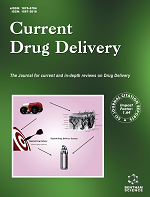- Home
- A-Z Publications
- Current Drug Delivery
- Previous Issues
- Volume 18, Issue 2, 2021
Current Drug Delivery - Volume 18, Issue 2, 2021
Volume 18, Issue 2, 2021
-
-
Recent Advances in Treatment of Lung Cancer: Nanoparticle-based Drug and siRNA Delivery Systems
More LessAuthors: Ayse Gencer, Ceren Duraloglu, Sena Ozbay, Turkmen T. Ciftci, Samiye Yabanoglu-Ciftci and Betul AricaLung cancer is the second most diagnosed cancer in both men and women worldwide. Considering the high mortality rate of lung cancer and inadequacy of conventional treatment methods such as surgical resection, chemotherapy and radiotherapy; new treatment strategies are an emerging area of interest. Nanoparticle-based drug and small interfering RNA delivery systems such as lipid, polymeric, inorganic, micel Read More
-
-
-
Current Status of Drug Delivery Approaches and Assay of Anti-Migraine Drugs
More LessAuthors: Ozgur Esim, Ayhan Savaser, Leyla Karadurmus, Nurgul K. Bakirhan, Sibel A. Ozkan and Yalcin OzkanMigraine is a chronic, painful, neurological disorder that affects approximately 15% of the population worldwide. It is a form of neurovascular headache: a disorder in which neural events result in the dilation of blood vessels that, in turn, results in pain and further nerve activation. The pathogenesis of migraine is not completely understood, but it is thought that both central and peripheral stimulations can play a role in Read More
-
-
-
Lipid-Coated Nanosized Drug Delivery Systems for an Effective Cancer Therapy
More LessAuthors: Ozge Esim and Canan HascicekCurrently, despite many active compounds have been introduced to the treatment, cancer remains one of the most vital causes of mortality and reduced quality of life. Conventional cancer treatments may have undesirable consequences due to the continuous differentiating, dynamic and heterogeneous nature of cancer. Recent advances in the field of cancer treatment have promoted the development of several novel na Read More
-
-
-
An Overview on Electrochemical Sensors Based on Nanomaterials for the Determination of Drugs of Abuse
More LessAuthors: Mandana Amiri, Hamideh Imanzadeh and Yasaman Sefid-SefidehkhanDrug abuse is considered a serious source of economic and social problems. The identification of drugs of abuse is in demand in forensic and clinical toxicology. There are various methods for the determination of these materials, including chromatographic and mass spectrometric techniques. However, most of these techniques need high-cost equipment, they are time-consuming, and they suffer from complicated Read More
-
-
-
Quetiapine Fumarate Loaded Nanostructured Lipid Carrier for Enhancing Oral Bioavailability: Design, Development and Pharmacokinetic Assessment
More LessAuthors: Shweta Agarwal, S.L. HariKumar, Poonam Negi, Navneet Upadhyay and Rajeev GargAims: The study aimed at developing and characterizing Nanostructured Lipid Carriers (NLC) of Quetiapine Fumarate (QF) by Design of Experiment (DoE) for the enhancement of bioavailability. Background: QF, an anti-psychotic drug, has an oral bioavailability of 9% due to hepatic first- pass metabolism necessitating the use of high doses. Its side effects are dose -related and enhancement in bioavailability would result in mini Read More
-
-
-
Topical Melatonin Niosome Gel for the Treatment of 5-FU-Induced Oral Mucositis in Mice
More LessBackground: Oral mucositis, one of the most common complications of 5-Fluorouracil (5-FU) treatment, leads to several problems, including pain, diarrhea and malnutrition, and reduces the quality of life and subsequent treatments. Melatonin, a neurohormone with anti-inflammatory and antioxidant activities, was encapsulated in niosomes and embedded in a mucoadhesive gel formulation as a Melatonin Niosome Gel (MN Read More
-
-
-
Betulinic Acid Nanogels: Rheological, Microstructural Characterization and Evaluation of their Anti-inflammatory Activity
More LessBackground: Betulinic Acid (BA) is a lipophilic compound with proven beneficial results in topical inflammation. Nanogels (NG) are carriers of bioactive compounds with properties that make them good candidates to treat skin diseases. Objective: The objective of this study was to evaluate the anti-inflammatory activity of BA carried in NG. Methods: NG were composed of a nanoemulsion and a crosslinking agent (Carbopol 9 Read More
-
-
-
Formulation, Characterization and Pharmacokinetics of Long-acting Ceftiofur Hydrochloride Suspension
More LessAuthors: Shuyu Xie, Xiaoqiu Zhang, Wanhe Luo, Kuiyu Meng, Dongmei Chen, Yuanhu Pan, Yanfei Tao, Lingli Huang, Zhenli Liu, Yulian Wang and Zonghui YuanObjective: A ceftiofur hydrochloride long-acting oily suspension with no irritation was prepared by testing and optimizing the types and amounts of organic solvents, suspending agents, and surfactants. Methods: Its properties, stability, injection site irritation, in vitro release, and pharmacokinetics in pigs were evaluated. The optimum formulation was used ethyl oleate, aluminum monosterate, and span-80 as orga Read More
-
-
-
Hyaluronic Acid/Parecoxib-Loaded PLGA Microspheres for Therapy of Temporomandibular Disorders
More LessAuthors: Dongwang Zhu, Haoran Bai, Wanning Xu, Wen Lai, Liting Song and Jiayin DengObjective: This study aimed to fabricate Hyaluronic Acid (HA)/parecoxib-loaded PLGA microspheres for the treatment of Temporomandibular Disorders (TMD) and investigate the in vitro and in vivo effect of the microsphere system to solve the issues of poor drug delivery and short duration on drug concentration in conventional TMD therapy. Methods: The microspheres were prepared by the double emulsion (w/o/w) Read More
-
Volumes & issues
-
Volume 22 (2025)
-
Volume 21 (2024)
-
Volume 20 (2023)
-
Volume 19 (2022)
-
Volume 18 (2021)
-
Volume 17 (2020)
-
Volume 16 (2019)
-
Volume 15 (2018)
-
Volume 14 (2017)
-
Volume 13 (2016)
-
Volume 12 (2015)
-
Volume 11 (2014)
-
Volume 10 (2013)
-
Volume 9 (2012)
-
Volume 8 (2011)
-
Volume 7 (2010)
-
Volume 6 (2009)
-
Volume 5 (2008)
-
Volume 4 (2007)
-
Volume 3 (2006)
-
Volume 2 (2005)
-
Volume 1 (2004)
Most Read This Month
Article
content/journals/cdd
Journal
10
5
false
en

Most Cited Most Cited RSS feed
-
-
Preface
Authors: Deng-Guang Yu and He Lv
-
- More Less

